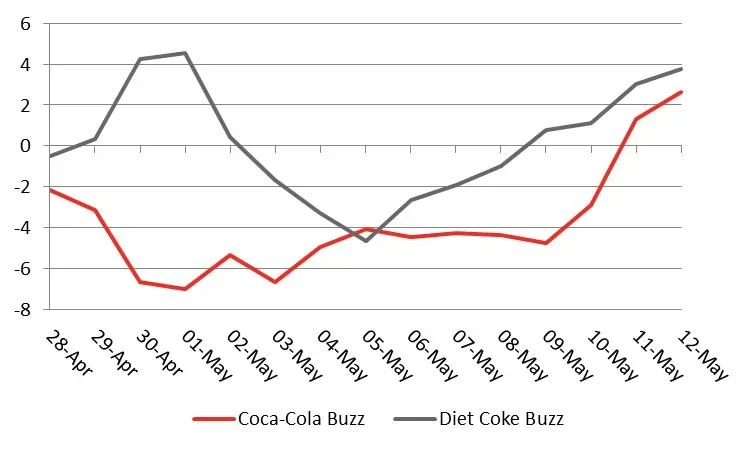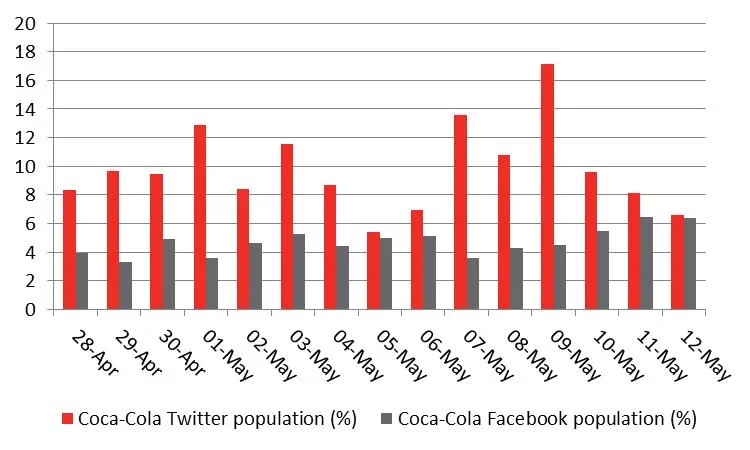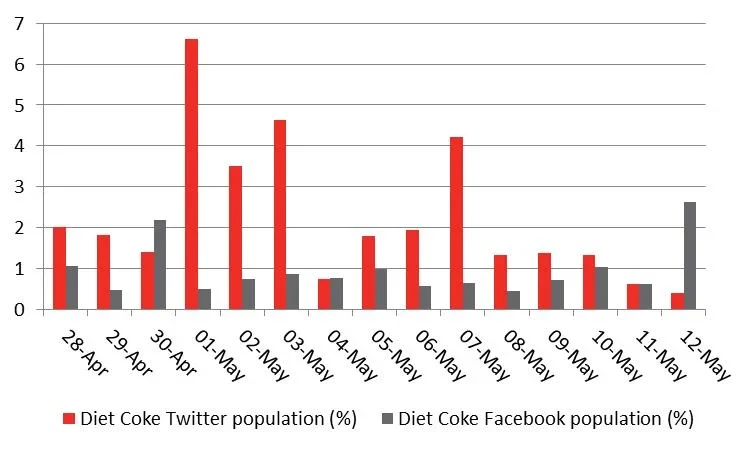This summer, Coca-Cola has decided for the first time to replace its iconic brand name on some of its bottles with 150 of Britain’s favourite names.
The names, which include ‘Dan’ & ‘Laura’ for example, will appear across individual 500ml and 375ml bottles of Coca-Cola, Diet Coke and Coke Zero, while on larger sharing and multipack bottles, the words ‘Friends’ and ‘Family’ feature. The thrust of this campaign is to encourage consumers to ‘share a coke’ with their friends, family and loved ones, including posting pictures of themselves with a Coke bottle bearing the name of a pal.
The ‘Share a Coke’ campaign was announced on 29 April, and while it is still in the early stages we have looked at its effectiveness for the Coca-Cola and Diet Coke brands.
Using YouGov’s brand perception tool, BrandIndex, we can gauge a brand’s buzz factor based on whether people have heard anything positive or negative about the brands through the media, advertising or word of mouth.
We can see that for the period 28 April to 12 May, both brands have increased their Buzz scores. Coca-Cola had a Buzz score of -2.1 on 28 April, which had risen to 2.6 on 12 May (+4.7), while Diet Coke had a Buzz score of -0.5 which had risen to 3.7 (+4.2) – this would indicate the campaign is working.

Measuring the campaign’s effectiveness on social media
Moving into the social media world, we can use YouGov’s social media analysis tool, SoMA, to try and ascertain what is behind this increase in Buzz, and to measure what messages different demographic groups were exposed to in relation to each of the Coke brands on Facebook and Twitter.
If we start with Coca-Cola, we can see that 51% of the UK Twitter population were exposed to a mention of Coca-Cola between 28 April and 12 May. This represents a rise of 3% for the two weeks prior to the campaign launch.
If we look at Facebook, we can see that Coca-Cola was proportionally more successful during this period, by reaching 40% of the UK Facebook population (a 5% increase in reach for the two weeks prior to the campaign).

SoMA also allows us to measure exactly what demographic audiences were exposed to Coca-Cola’s campaign on Twitter and Facebook. For example, while more males were exposed to Coca-Cola (51%) on Twitter, more females were exposed to the brand on Facebook (57%). Furthermore, on Twitter 54% of those who heard about Coca-Cola were aged 18-34, while on Facebook 45% of those exposed to Coca-Cola were aged 18-34.
This indicates that different audiences were exposed to Coca-Cola on the two social networks - an insight that could be used to adapt the social media campaign strategy.
By looking at Diet Coke, however, we can see evidence that different messages were heard on the social networking sites.
By looking at the most popular words found next to Diet Coke on Twitter, it is clear that the latest marketing campaign was not the primary driver of activity.
The words ‘machine’(9.2%) and ‘vending’ (8.7%) were found next to Diet Coke more frequently than the words ‘name’ (8.54%) and ‘bottle’ (7.39%). This is in reference to the fact that Diet Coke launched a slim vending machine. This tells us that Diet Coke’s Twitter activity during this period was not entirely driven by the ’Share a Coke’ marketing campaign.
However, by looking at the most popular words found next to Diet Coke on Facebook, we can see that overall Facebook reach (11%) was driven largely by the latest marketing campaign.

Therefore, at a top level we are able to demonstrate that overall Buzz has increased for both Coca-Cola and Diet Coke - meaning that more people have heard something positive about the brands since the campaign launched.
By using SoMA we can also measure exactly what people heard about Coca-Cola and Diet Coke on Facebook and Twitter.
By overlaying demographic insights with what the UK’s Facebook and Twitter population are hearing, Coca-Cola and Diet Coke could gain valuable insight. This analysis indicates that both Coca-Cola and Diet Coke have been more successful on Facebook than Twitter. It also shows that different audiences are hearing about the brands on different social networks. This insight could be used by Coca-Cola and Diet Coke to adapt their social media campaigns in order to effectively communicate the right message to the right audience.






